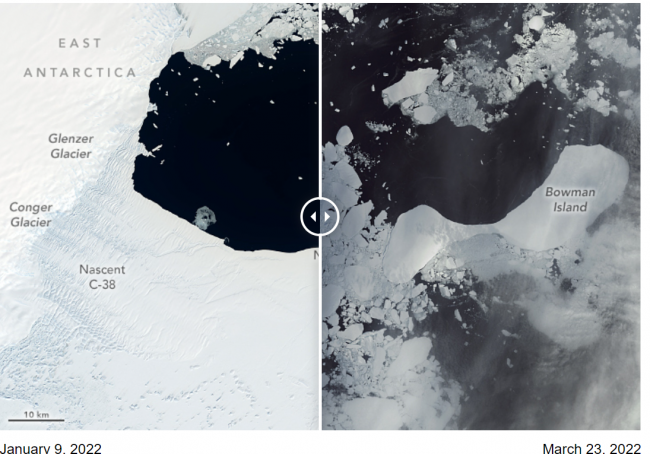Articles Menu

Mar. 25, 2022
For the first time in human history, an ice shelf in East Antarctica has collapsed, scientists said Friday, as climate change shows no signs of slowing.
The collapse of the 463-square-mile Glenzer Conger ice shelf, which occurred last week, came as temperatures rose in the eastern section of Antarctica by as much as 70 degrees Fahrenheit above normal. That was enough in some places for rain, rather than snow, to fall, the Associated Press reported.
NASA satellites first detected the collapse of the ice shelf.
The extreme heat and the collapse of the ice sheet, which helped keep the Conger and Glenzer glaciers from hitting warming water, is causing alarm among scientists who had considered the area to be stable — unlike other regions, where fears of the collapse of glaciers could lead to massive sea level rise worldwide.
“The Glenzer-Conger ice shelf presumably had been there for thousands of years, and it’s not ever going to be there again,” University of Minnesota ice scientist Peter Neff told the AP.
Ice shelves, which extend over water, help keep ice further inland from flowing into the ocean. As human beings continue to pump greenhouse gases into the atmosphere, global air and water temperatures continue to rise. "Upper ocean temperatures to the west of the Antarctic Peninsula have increased over 1°C since 1955," according to the British Antarctic Survey. "It has now been established that the Antarctic Circumpolar Current is warming more rapidly than the global ocean as a whole."
While most scientists have been focused on the western section of Antarctica, where the Thwaites Glacier, which is the size of Florida, is in danger of collapse, the revelation that ice in the eastern section of the continent is also at risk of collapse due to climate change is worrisome.
The eastern portion of Antarctica contains more than five times the ice that is found in the West Antarctic Ice Sheet, the AP reported. If all of the ice in the east was to melt, scientists say, sea levels would rise by more than 160 feet.
The good news is that it would likely take centuries at the current rate of warming for eastern Antarctica to lose all of its ice. The bad news, however, is that melting there is adding to a problem that scientists believe has already locked in several feet of sea level rise. What remains unknown, however, is how much seas will rise because of melting polar ice caps over the coming decades.
“Think of it this way: If I dumped a truckload of ice in the middle of Phoenix, we’d all know it’s going to melt. But it takes time to melt," Benjamin Strauss, the president and CEO of Climate Central, a nonprofit that tries to educate policymakers and the public about the threats posed by climate change, told Yahoo News. "And the same thing is true for the big ice sheets on Greenland and Antarctica and glaciers around the world. We turned up the thermostat. We’ve already heated the planet by a couple degrees, but they’ve only begun to respond by melting. And that’s why we have all this extra sea level in the pipeline.
"It’s hard to imagine the long-term future of South Florida, let’s say," he added, "with the sea level that’s already in the pipeline.”
[Top photo: Ice Shelf Collapse in East Antarctica - NASA https://earthobservatory.nasa.gov/images/149640/ice-shelf-collapse-in-east-antarctica]